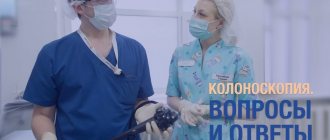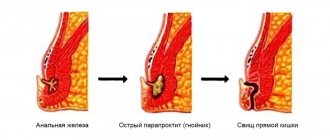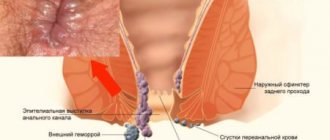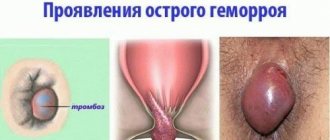A fistula or fistula of the rectum is a pathological opening under the mucous membrane of the anal canal, which begins inside the rectum and ends with an external opening in the perineal or perianal area.
The result of the formation of a fistula is the release of feces through it to the surface of the skin, and not through the natural route. Also, a fistula (chronic paraproctitis) causes constant pararectal infection of the tissue, forming a permanent focus of inflammation. Rectal fistula is most often a consequence of acute paraproctitis.
Paraproctitis is an inflammation of the purulent nature of the tissues of the rectum and anus. The main causative agents of the disease are Staphylococcus aureus and Staphylococcus aureus, Enterococcus, Escherichia coli, as well as a combination of these pathogens. Infectious agents penetrate the ducts of the anal glands through damage to the skin of the anal area or microtraumas of the rectal mucosa (undigested food particles, hard lumps of feces, etc.), from where they are transported into the perirectal tissue, causing its inflammation.
Often paraproctitis occurs due to the presence of pathologies and infectious diseases in neighboring organs (pelvic peritonitis, osteomyelitis of the pelvic bones, tuberculosis, syphilis, etc.), after operations on the rectum or birth injuries (prolonged labor, rupture of the birth canal). The affected cells are gradually destroyed, which allows the fistula to break out and reach the surface of the skin.
Factors contributing to the development of paraproctitis are:
- bowel disorder (constipation/diarrhea);
- untreated hemorrhoids or injuries to prolapsed hemorrhoids;
- inflammatory diseases in the rectum (ulcerative proctitis, Crohn's disease, etc.);
- a history of anal abscess.
The absence or ineffective treatment of acute paraproctitis causes the development of a chronic form of the disease, which is manifested by the formation of a rectal fistula.
Chronic paraproctitis is classified depending on:
- on the location of the fistula within the rectum: intra-, trans- and extrasphincteric;
- from etiology: vulgar, specific and anaerobic;
- from the direction of the fistula: complex and simple (direct fistula tract)
- on the nature of the opening in the rectum: complete (has 2 or more openings) and incomplete (end blindly in the perirectal tissue).
What does a rectal fistula look like?
Clinical signs of rectal fistula depend on the source of inflammation and the duration of the disease.
However, most often the occurrence of this pathology is accompanied by:
- the presence of a wound surface from which pus, feces or ichor is released;
- irritation of the skin around the fistula;
- pain during bowel movements (in some cases the pain is chronic);
- anal itching;
- violation of the tone and function of the anal sphincter;
- general symptoms (weakness, increased body temperature, etc.).
Depending on the type of fistula, single or multiple fistulas appear on the surface of the skin of the perianal area.
Periodic blockage of the fistula tract with pus or necrotic tissue causes exacerbation of inflammation and leads to the accumulation of pus in the perirectal tissue, which subsequently opens spontaneously or with surgical help.
Treatment without surgery at home
Surgery is not always used. In the early stages of proctological disease, laser therapy is also performed. There is no discomfort or pain during the procedure. The recovery period is significantly reduced. The risk of relapse and complications is reduced. After laser excision, tissue structures heal quickly, inflammation disappears.
Sitz baths have an effective effect. The patient makes baths at home with sea or iodized salt, with medicinal herbs and infusions. To prepare the contents, use a tablespoon of salt and baking soda. These components are added to five liters of filtered water and filtered. The patient takes a bath in a sitting position for twenty minutes. The course of treatment is fourteen days.
Sea and iodized salt affect the discharge of purulent masses, eliminate the inflammatory and infectious process in the body. Quite often, medicinal herbs are used for anal fistula. Proctologists advise preparing a decoction of calendula, chicory, oak bark and chamomile. The above components are mixed with a liter of filtered water. The water is infused with herbs and then filtered. The contents are diluted with five liters of warm water.
The bath is done in a sitting position for ten minutes. The course of treatment averages ten days, depending on the patient’s condition. You should not start treatment without consulting a proctologist and your attending physician. Make an appointment with a coloproctologist at the private proctology clinic “Proctologist 81”.
A medical specialist will conduct an initial examination and, using palpation, determine the location, size and structure of the fistula. After this, each patient is sent for testing. It is necessary to take a general blood, urine and stool test. In some cases, a blood glucose test will be required. The patient attends various diagnostic tests that will help establish an accurate diagnosis. These include radiography, ultrasound diagnostics, and magnetic resonance imaging.
Why is rectal fistula dangerous?
The lack of treatment for chronic paraproctitis not only significantly complicates a person’s life, but also leads to the development of a number of complications.
Among the most common consequences of rectal fistula, experts identify:
- deformation of the muscles of the perineum and anal sphincter, which subsequently becomes the cause of fecal incontinence (rigidity of the anal sphincter);
- cicatricial processes in the wall of the rectum;
- formation of purulent cavities in soft tissues;
- sepsis;
- malignancy (malignancy) of pathology.
Symptoms of anal fistula
When fistulas form near the anus, certain symptoms are observed.
- Blood and ichor are released from the anus, an unpleasant pungent odor, purulent and mucous discharge appear.
- The patient notices pain in the affected area.
- Inflammation develops, the epidermis becomes irritated and swells.
- Purulent compactions form near the fistula, which bleed when pressed.
- The patient loses his appetite and sleep is disturbed. The patient becomes irritable, nervous, and quickly gets tired.
- The process of bowel movements and urination is disrupted.
- Blood clots, pus and mucus are found in the stool. When defecating, the patient strains, which causes spasms and pain in the intestines.
- With a complex fistula, serious local processes develop. The shape of the anus changes, anal fissures and scars appear. Wounds form on muscle structures that bleed regularly.
A common complication is sphincter pathology, which, if left untreated, leads to the appearance of malignant tumors.
When an anal fistula forms, pectenosis develops in parallel. Scars appear on the walls of the anus, after which the canals are injured and tightened.
How to treat rectal fistula?
The tactics and composition of therapy are determined by the type and stage of the disease, as well as the patient’s physical health.
Thus, information about the number of fistulas, their size and characteristics, the nature of the discharge from them, as well as the presence of cicatricial changes in the intestinal wall carries important diagnostic significance.
Before prescribing a course of therapy, differential diagnosis must be carried out, since the choice of treatment method is directly dependent on the data obtained.
Often the examination includes:
- probing the fistula tract to determine its direction, the presence of purulent pockets and branches in it;
- fistulography (x-ray contrast study);
- anoscopy to assess the shape and length of the fistula canal;
- sigmoidoscopy to identify concomitant pathologies of the sigmoid and rectum;
- sphincterometry to determine the tone of the sphincter and the degree of its closing function;
- Ultrasound of pararectal tissue spaces;
- use of methylene blue (dye test);
- cytological scraping and histological analysis of the fistula tract, etc.
The only effective way to treat rectal fistula is surgery. Depending on the characteristics of the pathology and the duration of its course, certain methods of removing a rectal fistula are used.
Among the methods of excision of a fistula there are:
- an incision followed by suturing of the sphincter muscles (especially when deep tissues are affected);
- dissection;
- laser cauterization;
- excision followed by plastic surgery;
- filling with biomaterials;
- application of ligatures, etc.
A ligature is a silk thread that is inserted along the fistula and tied, completely covering the muscle layer of the anus. During dressings, the ligature is gradually tightened, which leads to dissection of the sphincter muscles, maintaining its functionality.
But the most popular and effective method of surgical treatment is minimally invasive intervention, since it not only successfully eliminates pathology, but also reduces postoperative risks and shortens the recovery period.
Today, the Austrian disposable instrument FiXcision is used to simultaneously excise the fistula and restore the integrity of the rectum.
The advantages of using FiXcision during minimally invasive surgery are its ability to:
- probing;
- tissue compression;
- excision of the fistula with a circular blade (followed by histological examination of the material).
The use of FiXcision can significantly speed up the surgical procedure; it lasts about 30 minutes and does not require general anesthesia or hospitalization of the patient.
However, there are a number of contraindications for the procedure, including:
- serious diseases of the kidneys, cardiovascular and respiratory systems;
- blood diseases;
- diabetes;
- acute infectious process;
- presence of tumors;
- an episode of acute paraproctitis less than 8 months before the procedure, etc.
According to clinical data, opening and draining the abscess without closing the fistula itself leads to the re-formation of a rectal fistula, so subsequent surgery is necessary for a complete recovery and prevention of relapse.
Diagnostics
If you experience similar complaints, you should contact a specialist as soon as possible. After the examination, the doctor will accurately establish the diagnosis and choose the optimal treatment method, as well as determine the need for urgent surgery. Additional instrumental studies may also be required if the diagnosis is unclear and other pathologies have been excluded.
In the case of acute paraproctitis or abscess, surgical treatment should be carried out as soon as possible, so the doctor will suggest that you undergo only the most necessary studies and tests that will not delay the operation.
Outside of the acute period, you will need to undergo standard examinations and tests for hospitalization, as well as additional tests such as MRI and pelvic ultrasound. This will help the doctor determine the extent of the disease, predict the extent of the operation and choose the most appropriate technique.
At the initial appointment, after collecting complaints and medical history, the doctor begins an examination of the perineum and a rectal digital examination. The external fistula opening is quite easily visualized in the perineum, buttocks or near the anus. The doctor can palpate the internal fistula opening only during a rectal digital examination of the rectum or anoscopy. In order to assess the course of the fistula and its location relative to the sphincters, to determine the presence of leaks or additional passages, an MRI of the pelvis is performed. Also, during the examination, the doctor assesses the functionality of the anal sphincters and, if necessary, anal manometry can be prescribed, which will accurately determine the functional state of the sphincters.
To exclude rectovaginal fistulas, which connect the vagina and rectum, women also undergo a vaginal examination.
In some cases, for the differential diagnosis of other diseases of the rectum, and especially for patients over 45 years of age who are at risk of intestinal cancer, a colonoscopy is required.
How to prepare for surgery to remove a fistula?
The composition of the preparatory stage before surgery to remove a fistula depends on the type of pathology.
Thus, intrasphincteric fistulas (about 40% of cases) are characterized by mild scarring, a straight shape of the fistula canal and a location close to the anus. These features predetermine the possibility of using conservative treatment as a way of preparing for the removal of a rectal fistula.
Preparatory measures for surgical treatment of intrasphincteric fistula include:
- washing with antiseptic agents;
- local use of antibiotics;
- microenemas with medications, etc.
Transsphincteric fistulas can have both straight and curved passages, contain purulent cavities in the tissue and be accompanied by the formation of scars in the surrounding tissues. Preparation for surgery to remove this type of fistula consists of anti-inflammatory therapy and preliminary drainage of purulent cavities.
Extrasphincteric fistulas (about 15% of cases) are characterized by long winding canals with purulent leaks and scars.
A set of preparatory procedures before removing an extrasphincteric fistula of the rectum of varying degrees of complexity (from 1 to 4) consists of:
- daily rinsing of the fistula tract with an antimicrobial solution;
- treatment of concomitant diseases of the rectum;
- administration of microenemas with a medicinal solution;
- special treatment of the pararectal area.
It is known that the probability of relapse during the treatment of extrasphincteric fistulas is 8–16%, however, careful adherence to pre-operative preparation measures significantly reduces this risk.
Recommendations for preventing relapse
To avoid relapse of paraproctitis, which threatens the re-development of paraproctitis fistula, it is enough to follow simple rules:
- Drink enough fluids daily (up to two liters per day);
- Stick to a balanced diet: with cereals, fresh vegetables, fruits (preferably enriched with fiber - zucchini, pumpkin, plums, bananas, apricots);
- Eat rye and wheat bran, which facilitates bowel movements and eliminates constipation;
- Use laxatives and cleansing enemas carefully;
- Control body weight to avoid obesity;
- Have sufficient physical activity, avoid excessive exercise and heavy lifting.
The Yusupov Hospital in Moscow is equipped with all the necessary medical equipment, which is used in the diagnosis and treatment of any diseases in the field of proctology, including paraproctitis and its complication - paraproctitis fistula.
The clinic's proctologists use advanced techniques and the latest technologies in their practice to ensure high treatment results. For a comfortable stay of patients, the Yusupov Hospital has cozy rooms, round-the-clock medical care is provided, and individual nutrition is organized taking into account the diet recommended by the doctor. Make an appointment
Forecast and prevention of perirectal fistula
Intra- and transsphincteric fistulas of low localization respond well to treatment and rarely recur. Deep extra- and transsphincteric fistulas are characterized by a long course of the disease and frequent relapses.
To avoid the appearance of pathology, you need to try to exclude injuries to the rectum and treat paraproctitis in a timely manner.
Author of the article:
Volkov Dmitry Sergeevich |
Ph.D. surgeon, phlebologist Education: Moscow State Medical and Dental University (1996). In 2003, he received a diploma from the educational and scientific medical center for the administration of the President of the Russian Federation. Our authors
Subcutaneous form
The subcutaneous form is the most common, accounting for more than 50% of cases. Its main symptoms are acute pain that worsens during bowel movements or movement. Body temperature usually rises to 39 degrees and is accompanied by chills. During a diagnostic examination, the patient is found to have hyperemia, deformation of the anal canal, and swelling. When palpated, the pain around the anus only intensifies. Therefore, during palpation it is advisable to use anesthesia, since this will make it possible to more accurately determine the size of the infiltrate, and then make the right decision about its elimination.










